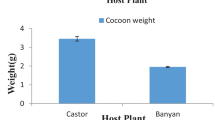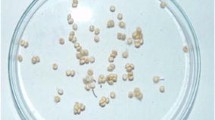Abstract
Silkworm Bombyx mori L. (Lepidoptera: Bombycidae) is a monophagous insect that feeds only on mulberry leaf. During rearing, shortage of a variety may engender a shift to another available mulberry variety to complete the rearing process. This study was carried out to assess the effect of host shift on B. mori fifth larval instar and the quality of cocoon produced. Silkworm eggs incubation and rearing of larvae were carried out following the standard procedures. There were four treatments consisting of different feeding components: sole mulberry variety S30, sole mulberry variety S14, host shift from mulberry variety S30 to S14 and host shift from mulberry variety S14 to S30. The treatments were arranged in a Completely Randomized Design with three replicates. At the fifth larval stage the worms were mounted on mountage and the spurned cocoons were harvested five days after. Host shift from mulberry S30 to S14 gave the highest fifth larval weight (2.29 ± 0.0 g) which was significantly higher than 1.99 ± 0.02 recorded on S14 sole feeding. The smallest single cocoon weight (1.07 ± 0.01 g), single pupal weight (0.96 ± 0.02 g) and single shell weight (0.10 ± 0.01 g) were obtained from sole feeding on mulberry S14.There was no significant difference in the total cocoon weight across the treatments. Silkworm larval survival, larval developmental period and number of cocoon formed were not negatively influenced either by sole feeding or shift in varietal feeding. Therefore, rearing process of silkworm that commenced with S14 or S30 can be completed with either of the varieties in the absence of one.

Similar content being viewed by others
References
Adeduntan SA (2015) Influence of different varieties of mulberry leaves (Morus alba) on growth and cocoon performance of biovoltine strain of silkworm (Bombyx mori) Int. J Biol Chem Sci 9(2):751–757
Adolkar VV, Raina SK, Kimbu DM (2007) Evaluate of various mulberry Morus spp. (Moraceae) cultivars for the rearing of the bivoltine hybrid race Shaanshi BV-333 of the silkworm Bombyx mori (Lepidoptera: Bombycidae). Int J Trop Insect Sci 27:6–9
Alebiosu IB ( 2011) Performance of two hybrid races of silkworm (Bombyx mori L.) on mulberry species S30 leaves in South-West Nigeria. Dissertation, Federal University of Agriculture, Abeokuta, Nigeria
Ashiru MO (2002) The effect of mulberry varieties on the performance of Chul Thai 5 silkworm race. Discov Innov 14:77–83
Ayandokun AE, Amata NA, Adeoye OT (2018) Assessment of the combination of two selected mulberry varieties (Morus alba), S14 and S30 as compared with single variety fed to silkworm (Bombyx mori) on the insect performance. Int J Sci Technol 6(3):81–85
Badejo SO, Alebiosu IB, Baiyewu R, Idowu J B (2009) A practical guide on mulberry sericulture. Mozabeth Royal Prints, pp 21
Bharath KN, Shivkumar GM, Babulal GMK (2017) Autumn crop over spring in temperate region of Jammu and Kashmir. J Agroecol Nat Resour Manag 4(2):112–114
Bharath KN, Gulzar AK, Mudasir G, Shakeel AM, Ghosh MK (2018) Exploration of sericulture in unexplored region of Jammu and Kashmir. J Entomol Zool Stud 6(4):1922–1925
Food and Agricultural Organization, FAO (1998) Tropical feeds, 8th edn. FAO, Rome
Jaiyeola V, Adeduntan S A (2002) Sericulture in Ondo State. A means of alleviating rural poverty of Forestry and Challenges of Sustainable Livelihood. Proceeding of the 28th Annual Conference of the Forestry Association of Nigeria held in Akure, Ondo State, pp. 202–207
Jindra M, Sehual F (1989) Larval growth, food consumption and utilization of dietary protein and energy in Calleena mellonella. J Insect Physiol 35:719–724
Kanafi RR, Ebadi R, Mirhosseini SZ, Seidavi AR, Zolfaghari M, Etebari K (2007) A review on nutritive effect of mulberry leaves enrichment with vitamins on economic traits and biological parameters of silkworm Bombyx mori L. Intervert Surviv J 4:53–58
Miyashita V. 1986. A report on mulberry and training methods suitable to bivoltine rearing in Karnataka. Central Silk Board. 1–7
Muthukrishnan J, Madhavan S, Navarathna JV (1978) Effect of restriction of feeding duration of food utilization, emergence and silk production in Bombyx mori L. (Lepidoptera: Bombycidae). Mon Zool Italia-Italia J Zool 12:87–94
Priyadharshini P, Maria JA (2016) Sericigenous insects. J Int Acad Res Multidiscip 4(11):59–68
Radhakrishnan S, Periasamy K (1986). Studies on the selection and method of cultivation of mulberry. In: Anonymous (ed.) Proceedings of National Seminar on Prospects and Problems of Sericulture pp. 27–30
Ramesha C, Anuradha C, Lakshmi H, Sugnana KS, Seshagir SV, Goel AK, Suresh KC (2010) Nutrigenetic traits analysis for the identification of nutritionally efficient silkworm germplasm breeds. Biotechnology 9(2):131–140
Rathore MS, Srinivasula Y, Kour R, Darzi GM, Anil D, Khan MA (2011) Integrated soil nutrient management in mulberry under temperate conditions. Eur J Biol Sci 3(4):105–111
Smith OB (1994) Using fodder from trees and shrubs to feed livestock in the tropics 23 better farming series. 42. FAO, Rome
Sumioka HS, Kunda S, Yoshitake N (1982) Relationship among food ingestion, food digestion and body weight gain in the silkworm larvae Bombyx mori under restricted feeding by indices. J Sericultur Sci 5(1):52–57
Yadav N (2013) Social status of women engaged in sericulture enterprise in Uttarakhand. Int J Adv Res Manag Soc Sci 13(2):45–49
Zhishen J, Mengcheng T, Jianming W (1999) The determination of flavonoid contents in mulberry and their scavenging effects on superoxide radicals. Food Chem 64:555–559
Funding
This study was funded by the authors.
Author information
Authors and Affiliations
Corresponding author
Ethics declarations
The study on Bombyx mori did not involve the use of either animal or human, hence, compliance with ethical standard is not applicable.
Conflict of interest
The authors declare that they have no conflict of interest.
Additional information
Publisher’s note
Springer Nature remains neutral with regard to jurisdictional claims in published maps and institutional affiliations.
Rights and permissions
About this article
Cite this article
Ayandokun, A.E., Alamu, O.T. Cocoon production efficiency of silkworm (Bombyx mori L.) in response to host shift between two selected mulberry varieties. Int J Trop Insect Sci 40, 49–52 (2020). https://doi.org/10.1007/s42690-019-00051-4
Received:
Accepted:
Published:
Issue Date:
DOI: https://doi.org/10.1007/s42690-019-00051-4




